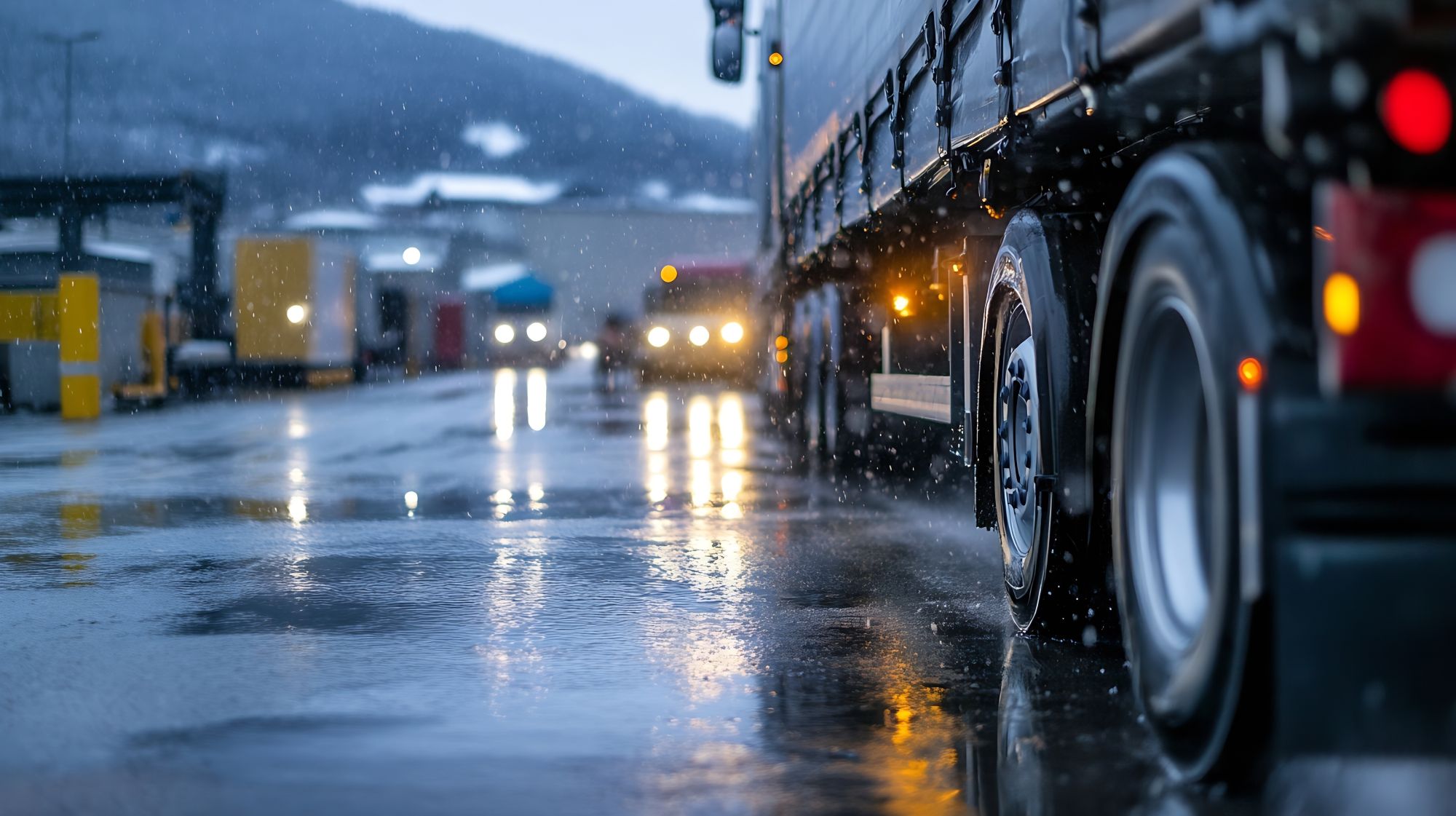
Guest
Sådan påvirker klimaforandringerne mobilitetssektoren
Oprettet: 21.07.2025
•
Opdateret: 21.07.2025
Klimaforandringer er ikke længere en fjern risiko. For dem, der arbejder med vejtransport, er det en daglig driftsmæssig realitet - som bliver sværere at ignorere for hvert år, der går. Fra hedebølger, der får asfalten til at smelte, til oversvømmelser, der afskærer store ruter - konsekvenserne af et skiftende klima er en del af det at flytte varer.
For flådechefer betyder det, at de skal navigere i skiftende regler, opdatere infrastrukturen og genoverveje kontinuitetsplanlægningen. For chaufførerne betyder det, at de skal tilpasse sig nye risici på vejen - fra punkterede dæk til afbrudte leveringsvinduer. Og for hele sektoren signalerer det behovet for en mere modstandsdygtig og klimabevidst tilgang til mobilitet.
Vejrforstyrrelser er en operationel trussel
I juli 2022 oplevede Storbritannien sin varmeste dag nogensinde. Da temperaturen steg til 40℃, begyndte vejene at blive bløde, og dele af A14 blev lukket på grund af nedbrydning af overfladen. Flådeoperatører blev tvunget til at omdirigere leverancer, nogle gange med kort varsel, mens motortemperaturerne steg, og køretøjerne kæmpede for at opretholde ydeevnen.
Samme år forårsagede kraftige vinde fra [Storm Eunice] (https://www.theguardian.com/world/2022/feb/18/flights-and-trains-cancelled-as-storm-eunice-hits-europe) omfattende skader på tværs af godskorridorer i Vesteuropa, hvor højtsiddende køretøjer væltede og temperaturfølsomt gods blev beskadiget. I mellemtiden oversvømmede stormen Henk i januar 2024 store områder i det centrale England. Vigtige ruter i Midlands var ufremkommelige, og nogle chauffører var strandet i timevis.
Det er ikke isolerede hændelser. De er tegn på et transportsystem, der bliver stadig mere sårbart over for klimatrusler. Vejbelægninger, køretøjskomponenter og logistiknetværk bliver alle testet af ændrede forhold - og konsekvenserne mærkes i hele forsyningskæden.
Forstyrrede forsyningskæder
Når det drejer sig om klimarelaterede forstyrrelser, mærkes konsekvenserne ikke kun på de enkelte ruter. Hele forsyningskæder bliver påvirket - nogle gange uden varsel. I Holland får stigende vandstand i havene og kraftigere nedbør myndigheder og virksomheder til at revurdere den kritiske logistikinfrastrukturs modstandsdygtighed, især i lavtliggende industriområder.
Rotterdam Havn - Europas største havn - har taget aktive skridt for at tilpasse sig klimarisikoen ved at forstærke kajmure, hæve adgangsveje og opgradere regnvandssystemer for at beskytte mod oversvømmelser. Logistikcentre inde i landet er også under lup, da ekstremt vejr har afsløret sårbarheder i adgangsveje og dræning.
Innovation inden for transport
Flådeteknologien forbedres hurtigt, især når det gælder elektrificering og intelligent diagnosticering. Men klimaforandringerne skaber nye belastninger for selv de mest avancerede køretøjer. Batteriets effektivitet kan falde med op til 20 % i koldt vejr, hvilket reducerer den effektive rækkevidde for elektriske varevogne. I mellemtiden fremskynder høje temperaturer nedbrydningen af dæk og lægger yderligere pres på køretøjernes kølesystemer.
For at løse disse problemer investerer nogle operatører i forebyggende vedligeholdelsessystemer, der bruger telematik til at forudse slitage og planlægge reparationer, før der opstår dyre fejl. Andre opgraderer førerhusets komfortsystemer for at beskytte chaufførens velbefindende i perioder med ekstrem varme eller kulde. Selv om disse ændringer indebærer en investering på forhånd, kan de give udbytte i form af oppetid, sikkerhed og fastholdelse af chaufføren.
Den stigende klimarisiko ændrer også forsikringerne. Nogle forsikringsselskaber reagerer på den øgede hyppighed af skader på grund af ekstremt vejr ved at hæve præmierne og skærpe undtagelserne. Især forretningsafbrydelsespolitikker er under større granskning, især hvor forsyningskæder er sårbare over for gentagne afbrydelser. Og selvom fragtforsikring stadig er en overvejelse, er det ikke alle policer, der automatisk dækker forsinkelser forårsaget af klimabegivenheder som oversvømmelser eller kraftig vind.
Flådechefer bør gennemgå deres dækning i lyset af disse nye risici. Det betyder, at de skal tjekke for undtagelser, vurdere, hvordan klimarelaterede hændelser defineres, og sikre, at kritiske huller - som f.eks. nedetid på grund af lukkede veje - er tilstrækkeligt dækket. I nogle tilfælde kan en proaktiv tilgang til risikostyring, oversvømmelsesbekæmpelse og chaufføruddannelse også være med til at sikre mere fordelagtige vilkår.

Det lovgivningsmæssige landskab
Mens de fysiske konsekvenser af klimaforandringerne allerede er synlige, tilføjer de lovgivningsmæssige ændringer endnu et lag af kompleksitet for operatørerne. Lavemissionszoner udvides hurtigt i Storbritannien og Europa, hvilket stiller nye krav til flådens sammensætning og overholdelse af reglerne. I London fortsætter Ultra Low Emission Zone (ULEZ) med at vokse, mens byer som Birmingham og Oxford har indført deres egne variationer.
På europæisk plan har pakken Green Deal og Fit for 55 sat ambitiøse mål for dekarbonisering. Flådeoperatører bliver tilskyndet - og i stigende grad pålagt - at skifte til renere brændstoffer og teknologier. Fra elektrificeringsmandater til regler om gennemsigtighed i forsyningskæden står operatørerne nu over for en ny basislinje for, hvad der betragtes som acceptabel forretningspraksis.
For dem, der administrerer flåder, er disse ændringer både en logistisk udfordring og en strategisk mulighed. Bæredygtighed handler ikke kun om at undgå bøder - det handler om at fremtidssikre driften og være på forkant med kundernes skiftende forventninger.
Opbygning af modstandsdygtige operationer
Tilpasning sker ikke fra den ene dag til den anden, men trinvise ændringer kan have stor betydning. Nogle operatører foretager nu klimarisikovurderinger på tværs af deres flådedrift og identificerer de aktiver og ruter, der er mest sårbare over for forstyrrelser. Andre tilbyder chaufførerne opdateret træning for at forbedre sikkerheden og beslutningstagningen under ekstreme vejrforhold.
Brændstofvalget ændrer sig også. Vognmænd, der er på udkig efter alternativer med lavere CO2-udledning, vender sig mod HVO - hydrogenbehandlet vegetabilsk olie - et alternativ til diesel, der reducerer udledningen uden at kræve ny infrastruktur. I mellemtiden ser de, der investerer i software til belastningsoptimering, ikke kun fordele i brændstoføkonomien, men også i emissionsreduktioner, der understøtter målene for overholdelse af reglerne.
Der er ikke længere nogen tvivl om, at klimaforandringerne former vejtransportens fremtid, ikke om årtier, men lige nu. Udfordringen for operatørerne er at skifte fra en reaktiv tankegang til en mere strategisk, langsigtet tankegang. Det betyder, at man skal forstå risiciene, handle på dem tidligt og erkende, at modstandsdygtighed hurtigt bliver en kilde til konkurrencefordele.
"Vi hører det samme fra flådeoperatører i hele Storbritannien og Europa," siger Nick Renton, chef for europæisk strategi og forretningsudvikling hos SNAP. "Klimaforstyrrelser er ikke en fremtidig risiko - de er her allerede og påvirker alt fra oplagring og ruteplanlægning til chaufførernes velfærd. De flåder, der trives, vil være dem, der behandler klimarobusthed som en forretningsstrategi, ikke bare en nødløsning.
"Det er vigtigt, fordi omkostningerne ved passivitet stiger - ikke kun økonomisk, men også i form af manglende leverancer, driftsstop og chaufførernes velbefindende på vejene. Hvis vi ønsker at holde varer i bevægelse og virksomheder i vækst, er vi nødt til at begynde at opbygge denne modstandsdygtighed nu."
Hos SNAP arbejder vi tæt sammen med flåder i hele Storbritannien og Europa for at hjælpe dem med at navigere i denne nye virkelighed. Uanset om det er gennem indsigt, partnerskaber eller smartere værktøjer til drift på vejen, er vi her for at støtte dem, der holder hjulene i gang - uanset vejret. Tilmeld dig i dag for at drage fordel af vores flådestyringsløsninger.



